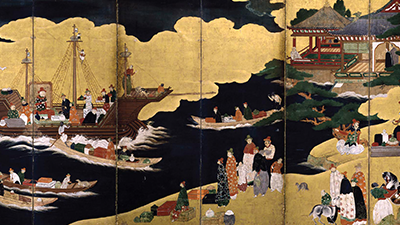Transoceanic Connections
Teacher Resources
Driving Question: How did transoceanic connections transform global economic systems and societies in different parts of the world?
Before 1492, long-distance trade networks connected societies all around the world. Yet, Oceania, the Americas, and Afro-Eurasia remained separate from each other. After 1492, these regions linked to form the first global network. New Oceanic empires crossed oceans, moving people, plants, animals, goods, and diseases to new places. This movement, which reshaped the world, is known as the Columbian Exchange.
Learning Objectives:
- Evaluate the historical narrative of expanding networks and the formation of a new global age.
- Explain how transoceanic connections linked communities after 1492 CE.
- Identify the major changes and continuities in the three frames from 1450 to 1750 CE.
Opener: Transoceanic Connections
Our Openers and Closers Guide provides more information about these short-but-important activities at the beginning and end of each lesson.
In this lesson, you’ll learn about transoceanic connections. This activity will give you a glimpse into what’s ahead—get ready to think about those new ideas!
Looking Ahead
Get an idea of how other teachers use Unit Notebooks by checking out this conversation in the OER Project Teacher Community.
Agree or disagree? Evaluate some statements before you dive into Unit 3—then see how accurate you were when you get to the end of the unit.
Transoceanic Connections
How are transoceanic connections and video games connected? Learn more in this blog post!
Today, the global economy is all around us. The video and article below will help you understand how these global connections began over 500 years ago.
-
Guiding Questions
-
Before you watch
Preview the questions below, and then review the transcript.
While you watch
Look for answers to these questions:
- How did the fall of the Mongol Empire change the way that long-distance trade networks worked after 1450?
- What were some global changes that came with the Columbian Exchange?
- What were the most powerful kinds of states during this period? What were their priorities?
- What was Manila’s role in this global trading system?
- What were some major demographic events in this era?
After you watch
Respond to this question: What are some ways that your life today is shaped by the changes caused by the first transoceanic connections?
Key Ideas
-
Guiding Questions
-
Before you read
Preview the questions below, and then skim the article. Be sure to look at the section headings and any images.
While you read
Look for answers to these questions:
- What was the Columbian Exchange, and why was it important?
- What were some of the land-based empires in the period, and why does the author suggest they emerged?
- What advantages did these land-based empires have?
- What were some important transformations in production and distribution that started in the Americas but also had broader effects?
After you read
Respond to this question: What are some things that you can use or eat daily that might not exist without the Columbian Exchange?
Frames in Unit 3
Want to see some student examples of frame drawing? Take a look at this conversation in the OER Project Teacher Community.
This video and activity will help us use the frames to evaluate the impacts of the first global networks between Afro-Eurasia and the Americas.
-
Guiding Questions
-
Before you watch
Preview the questions below, and then review the transcript.
While you watch
Look for answers to these questions:
- Why was the Columbian Exchange the world’s first global system?
- How did European entry to the Americas—and the conquest that followed—change communities?
- What were the large land-based empires that existed at the beginning of this period in and around former Mongol territory? Why did the dominance of these empires begin to fade?
- What were some large changes in this period related to the production and distribution frame?
- What were some large changes in this period related to the networks frame?
After you watch
Respond to the following question: How is it useful to view the impact of the Columbian Exchange through three different frames, rather than simply one?
Key Ideas
Closer: Transoceanic Connections
Want to do more with maps? Check out OER Project’s collection of maps here.
A lot changed from 1450 to 1750. How do you think people’s sense of the world changed in these three centuries?
Essay Review
Using either your own DBQ essay from Unit 2 or a sample essay, evaluate how well the writing shows claim and focus.






